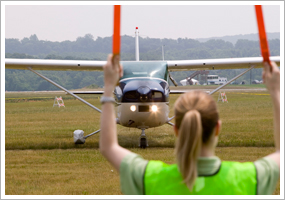| The following stories from the January 8, 2010, edition of AOPA ePilot were provided to AOPA members who expressed an interest in the particular subject areas. Any AOPA member can receive information tailored to their areas of interest by updating their preferences online. TRAINING TIPsHand signals
If there’s a common gripe among line crewmembers, it is that many pilots do not understand the signals used during the marshalling of aircraft to parking. If you fly mostly from an airport without much traffic, this operation may be unknown to you. It’s routine in busier places. At some airports it may be most efficient to park transient aircraft in a designated portion of the ramp, separate from larger or based aircraft. Different fixed-base operators may control different parking areas. Their employees direct you to the right spot. How did they know you were taxiing to the ramp? By monitoring ground control or CTAF.
Hand signals are the basic language of communications between ground crew and pilots. Mark Twombly reviewed the code in the December 2005 AOPA Flight Training column “What it looks like.” “Most hand signals are intuitive, such as the overhead crossed arms. Others are not so easily discerned. Do you know the hand signals for slow down, and the one for cut engine? You can and should study the rather rudimentary drawings for these and 10 other basic hand signals found in the Aeronautical Information Manual, Chapter 4-3-25,” he wrote.
Knowing the procedures speeds parking and keeps everyone safe. Complying starts with knowing where to look. “Normally the flagman will stand in front of the airplane and to its left side so as to be conspicuous in the pilot's field of view,” wrote Jeff Pardo in the February 2005 AOPA Flight Training feature “ Traffic signals: Do you understand aviation’s sign language?” See his discussion of how it’s done and how to avoid misunderstandings.
Knowing the signals is also a requirement for satisfactory completion of taxiing on the checkride. So be prepared to work with crewmembers at airports where you pay a visit. TRAINING PRODUCTSSporty’s DVD/online course comboSporty’s Pilot Shop is offering those pilots who want both the hard copy DVD and online course a discount on the second course. For pilots looking for the flexibility of an online course and the ownership of a DVD course, they can now buy both and save 50 percent on the second course. The deal is good for private, recreational, and instrument courses. Prices range from $149.95 for the recreational courses to $379.95 for the instrument courses. Find out more at Sporty’s online store.
Note: Products listed have not been evaluated by ePilot editors unless otherwise noted. AOPA assumes no responsibility for products or services listed or for claims or actions by manufacturers or vendors. FINAL EXAMQuestion: When draining the fuel samples from the tanks, I noticed the samples sometimes contain water. Knowing this isn't good, I want to learn more about fuel systems and contamination, particularly how to keep water out of the fuel tanks. Do you have any information online that would be helpful?
Answer: The AOPA Air Safety Foundation has a Fuel Awareness Safety Advisor. It includes information on fuel management, fuel systems, fuel contamination, and much more. Water can get into the fuel system several ways, but probably the most common problem is the condensation that can collect inside the fuel tanks when they are only partially full. A good practice is to keep the fuel tanks filled after each flight, and especially after the last flight of the day.
Got a question for our technical services staff? E-mail [email protected] or call the Pilot Information Center, 800/872-2672. Don’t forget the online archive of “Final Exam” questions and answers, searchable by keyword or topic. |
 You planned your solo cross-country flight in every last detail, flew it with precision, and know how to get where you’re going on the ground at your destination airport. Cleared to taxi, you have the parking ramp in sight. But what’s this? Someone is waving his arms to get your attention. Now he seems to be pointing with one hand and gesturing with the other. Back at your home airport there’s nothing like this. You realize there was one more thing you should have reviewed before flying.
You planned your solo cross-country flight in every last detail, flew it with precision, and know how to get where you’re going on the ground at your destination airport. Cleared to taxi, you have the parking ramp in sight. But what’s this? Someone is waving his arms to get your attention. Now he seems to be pointing with one hand and gesturing with the other. Back at your home airport there’s nothing like this. You realize there was one more thing you should have reviewed before flying.

